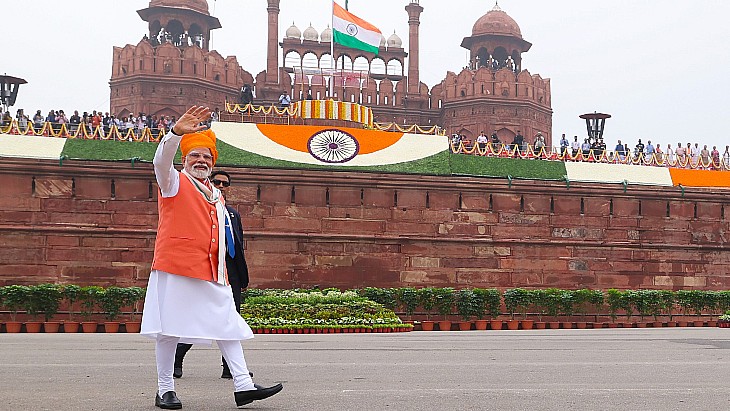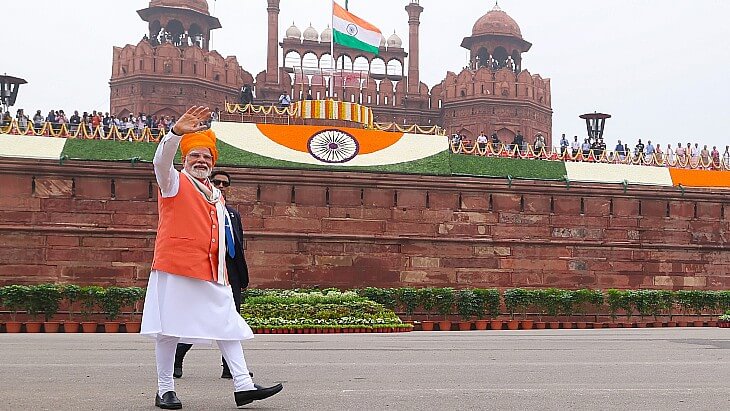1) India — Modi’s long Independence Day speech and big economic moves
This week Prime Minister Narendra Modi used his Aug 15 Red Fort address to roll out a major economic package: promises on GST reform (talk of fewer slabs and targeted cuts), fresh public spending on roads and energy projects, and measures pitched to lower everyday costs. The speech was unusually long and clearly aimed at sending a reassuring message to voters ahead of state elections. For ordinary people the immediate question is simple — will groceries, fuel or electricity become cheaper? For businesses, the big issues are timing and detail: small tax changes can change pricing strategies, and promised infrastructure spending only helps once funds are released and projects start. Economists are split — some say stimulus could boost short-term demand, others warn higher spending will raise fiscal pressures and could tighten borrowing conditions later. Watch the official policy notes over the next weeks for exact GST rates and implementation dates; that’s when markets and consumer prices will react.
Why it matters: Direct effect on household budgets and firm pricing; political timing could shape state polls.
Read more. Hindustan Times+1

2) Israel — plan to seize Gaza City raises humanitarian alarms
Israel’s security cabinet approved a plan to expand military operations in Gaza City — an area with dense populations and already critical shortages of food, water and medicine. Aid groups and the United Nations warned the move risks mass displacement and makes it much harder to deliver life-saving aid. Israel says the operation aims to dismantle militant infrastructure and free hostages; critics say a push into Gaza City could create a humanitarian catastrophe and inflame regional tensions. For civilians the reality is immediate: families may be forced to move, hospitals struggle to operate, and safe evacuation corridors are fragile. Diplomatically, the plan has prompted widespread concern and calls for protections for civilians while fighting continues. When you write this for readers, keep the focus human — who is at risk, where aid groups are trying to work, and what international actors (UN, Red Cross) are demanding. Also note internal debate in Israel: some security officials worry about the humanitarian fallout while political leaders press ahead.
Why it matters: A large offensive could multiply civilian suffering, disrupt aid, and widen regional instability.
Read more. ReutersAl Jazeera

3) Russia–Ukraine diplomacy — leaked conditions from Alaska talks and the hard politics
Reports from high-level meetings in Alaska this week described a Russian outline that would require Ukraine to give up control or accept special status for parts of Donetsk and Luhansk as part of a peace framework. Kyiv has openly rejected any settlement that amounts to ceding territory — for Ukrainian leaders that would be politically and morally unacceptable. The leak shows diplomats and leaders are exploring political routes even as fighting continues, but it also highlights a core problem: any peace that locks in Russian territorial gains is unlikely to be accepted in Kyiv or by many Western backers. Practically, that makes true diplomatic breakthroughs hard unless a formula is found that preserves Ukraine’s sovereignty while addressing security concerns — a very difficult balance. For readers: explain simply that diplomacy is happening, but the proposals on the table risk being political non-starters unless Ukraine agrees. Keep an eye on how this shapes Western military aid and public opinion inside Ukraine.
Why it matters: Peace proposals that demand land transfers are deeply controversial and could derail diplomatic progress.
Read more. The Times of IndiaWall Street Journal

4) U.S. tariffs — looming big levies on chips, steel and the ripple effect
Washington signalled new, steep tariffs this week — part of a drive to bring critical tech and metals production back to the U.S. The proposals focus on items like semiconductors and certain metals; some reports even mention sector-specific levies that could be very high for foreign-made chips. The immediate business response is sharp uncertainty: manufacturers that rely on cross-border supply chains need to rethink sourcing and contracts, and some companies may pass higher costs to consumers. For exporters — including suppliers in Asia and India — the risk is lost orders or squeezed margins. Markets have already priced in the risk: shares of firms tied to global supply chains moved as traders reacted. Politically, tariffs are popular with some domestic constituencies but typically invite retaliation or long trade negotiations. For your readers, highlight which goods could rise in price, how long supply chains might take to shift, and what businesses can do (inventory buffers, diversify suppliers).
Why it matters: Could raise consumer prices, reshape manufacturing locations, and spark wider trade responses.
Read more. ReutersSupply Chain Dive
5) Houthis and shipping — Red Sea warnings, insurance hikes and longer routes
Yemen’s Houthi group sent formal warnings to dozens of shipowners this week and continued attacks aimed at vessels it sees as linked to Israel. The result: shipping insurers raised premiums, some carriers rerouted around Africa to avoid the Suez/Red Sea route, and naval authorities issued higher-risk advisories. That matters fast: rerouting adds days or weeks to voyages and pushes up freight costs; higher insurance and security fees get baked into shipping bills and eventually consumer prices. Importers and exporters that depend on timely deliveries — electronics, retail goods, even some food items — face delays and uncertainty. For journalists, the most useful angle for readers is practical: explain how routes, port calls and delivery windows change, name industries likely affected first, and give businesses steps (short-term rerouting plans, higher buffer stock) to reduce risk. International navies and insurers are coordinating responses, but a long-term fix needs a political solution in Yemen and the region.
Why it matters: Disrupted sea lanes hit trade quickly — higher costs and slower deliveries for global commerce.
Read more. Splash247S&P Global

6) China — July data show weaker factory output and retail sales, cooling demand
China’s July numbers came in below expectations: factory output growth slowed and retail sales cooled — a sign household demand is not yet strong. That matters far beyond China’s borders because many countries sell parts, commodities or finished goods to Chinese buyers. When Chinese consumers and factories slow down, export orders to countries across Asia and beyond can drop, which affects jobs and growth elsewhere. Beijing usually has tools — targeted spending, credit support, or vouchers to households — but policy responses take time to reach the real economy. For businesses and investors, the key is watching which sectors (cars, consumer electronics, metals) show the biggest slowdowns and whether Beijing’s policy actions arrive quickly and at scale. For readers, translate it simply: weaker Chinese demand can mean fewer export jobs in other countries and pressure on commodity prices.
Why it matters: China’s demand shifts move global supply chains and commodity markets.
Read more. Reuters
7) Ukraine — steady fighting, shifting frontlines, urgent human needs
The battlefield picture this week was of continued, intense fighting with some local advances on both sides but no decisive front-line change. Independent analysts reported tactical shifts rather than broad breakthroughs. For civilians near the fighting, the toll is immediate: power outages, limited water and stretched medical services. Ukraine’s government continues to plead for Western weapons and ammunition to hold or regain ground, while diplomatic activity complicates decisions about aid and longer-term support. For your readers, the human stories matter most: which towns saw evacuations, where shelters are set up, and how aid groups are reaching people. Long-term, rebuilding needs will be vast even after fighting eases — planning for recovery now saves lives later.
Why it matters: Military moves shape humanitarian needs and the political will of donor countries.
Read more. Institute for the Study of WarInstitute for the Study of War
8) Hurricane Erin — fast strengthening, sea risks and shipping disruption
Hurricane Erin rapidly intensified over the Atlantic this week into a major storm, then shifted and weakened slightly as forecasters tracked its path. Rapid intensification is dangerous because it shortens preparation time for island communities and ships at sea. The most immediate impacts were extreme swells, port warnings and shipping route disruptions; Caribbean islands faced coastal flooding and heavy rains. For trade and logistics, storms like Erin can close ports, damage cargo and force large reroutes — all of which add to freight costs and delay arrivals. For readers: focus on safety guidance (local NHC updates, avoid flooded areas), and explain how these storms feed into insurance and shipping costs that can affect import timing or prices.
Why it matters: Big storms ripple from safety to shipping to prices for weeks after the worst weather passes.
Read more. Reuters+1
9) India monsoon extremes — heavy rains, red alerts in Maharashtra & Konkan
Parts of Maharashtra, Konkan, Goa and nearby pockets saw extremely heavy rainfall this week, with the India Meteorological Department issuing red and orange alerts. Flash floods, landslides and waterlogging forced road closures and local evacuations; rescue teams have been mobilised in affected districts. In cities such as Mumbai, sudden downpours overwhelmed drains and disrupted trains and traffic for hours. For readers, the practical points matter: follow local authority orders, avoid driving on flooded roads, and check verified helplines before donating — verified local relief channels work best. Longer-term, these events underline the need for better drainage, landslide mapping and resilient infrastructure in monsoon-prone zones. Economically, crops and small businesses in the worst-hit areas often lose income for weeks after floods.
Why it matters: Lives and livelihoods are at stake now — and recovery takes weeks to months.
Read more. The Times of India+1
10) Markets & supply-chain volatility — tariffs, geopolitics and weak China push risk premiums up
Markets this week reacted to several shocks: tariff threats from the U.S., fresh regional tensions (Middle East/Red Sea) and weaker Chinese data. The combined effect was higher risk premiums for shipping and certain commodities, volatile moves in exporter and chip stocks, and renewed caution by firms that run global supply chains. For consumers this can mean higher prices for some imported goods and longer delivery times. For companies the playbook is familiar: diversify suppliers, hold more buffer stock, and hedge where possible. For investors, the near term looks choppy until policy moves (tariffs, shipping security, central-bank signals) become clearer. The larger takeaway: policy shocks can re-price risk quickly — that’s why firms with flexible supply and better inventory controls do better when disruption hits.
Why it matters: Higher costs and delays could filter down into the things people buy and into corporate margins.
Read more. ReutersFinancial Times




